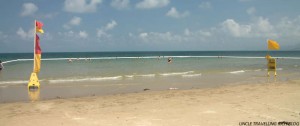In the last part of our three-part series on the Marine Stingers found in Far North Queensland, we will examine one of Australia’s most infamous dangerous animals: The Box Jellyfish. These animals can be found inshore around beaches during the rainy season summer months, typically November through to late May. While the number of stings has decreased dramatically thanks to control measures and awareness campaigns, it is still worth a bit of time familiarising yourself with this exotic yet dangerous creature.
Box Jellyfish:
Likelihood of being stung: Extremely Low
Danger of sting: High
The infamous box jellyfish developed its frighteningly powerful venom to instantly stun or kill prey, like fish and shrimp, so their struggle to escape wouldn’t damage its delicate tentacles. As such, it is considered one of the most potent toxins in the world. The box jellyfish venom is so potent that in severe cases victims can quickly go into cardiac arrest within minutes. If that’s the case obviously CPR (cardio pulmonary resuscitation) takes priority over everything else. Luckily it’s not always that bad. It depends where the tentacles touched (across the chest is obviously a lot more dangerous than on the ankle), and how much venom was released. Usually the most important thing to do first is to ring for help (000 in Australia). The next goal is to inactivate the remaining stinging cells. This should be done by pouring normal vinegar over the and soaking for at least 30 seconds. Many beaches will have signs posted and a small supply of vinegar, so if you are travelling around Far North Queensland, it is a good idea to include a large bottle of vinegar in your first aid kit.
But there is no reason to be afraid when visiting the beaches on our tropical paradise. The most popular beaches in areas prone to marine stingers have stinger-resistant enclosures so beachgoers can enjoy swimming throughout the year. It is important to swim inside the enclosures as they are the only safe swimming zone on the beach. The nets are constructed of a robust floating tube that defines the swimming area. Hanging from this floating tube is 25mm square mesh that descends to the ocean floor and is weighed down by chain. The stinger nets are designed to prevent large box jellyfish and large segments of box jellyfish tentacles from entering the enclosure. These areas are easily identified, and beachgoers unsure of where to swim can make enquiries to lifeguard staff at manned beaches.
So when you are visiting Cairns and the surrounding areas, be sure to do a bit of homework. Be aware of the season, find a beach with a safety net, and remember first aid skills. With a little bit of information and preparation, enjoying the warm tropical waters of Far North Queensland can be one of the most unforgettable experiences of a lifetime.

